KODANGALLUR DEVI TEMPLE
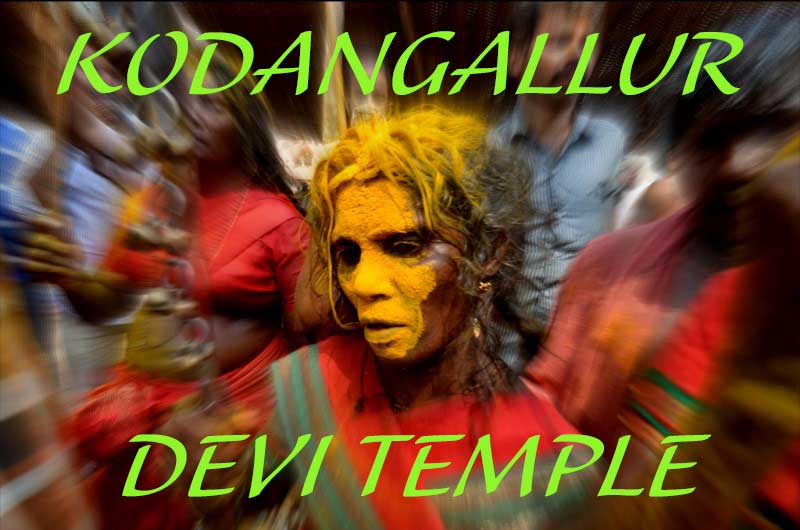
The
Sri Kurumba Bhagavati also known as Kodungallur Devi temple is one of
the most powerful Shakti peethas in Kerala. The archives of the temple
prove that it is also one of the most ancient temples in Kerala. The
history of the town of Kodungalloor belongs to the hazy past. The story
starts 3,000 years ago when the Babylonians, Assyrians and Egyptians
came to the Malabar Coast in search of spices and especially pepper.
Later the Arabs and Phoenicians also started to come. The town was
called Muziris by the Phoenicians and was a very important city on the
ancient trade route. In fact it was the earliest port of its kind. It is
even mentioned in the Ramayana where it is called Murachipattanam and
is one of the places mentioned by the monkey hoards which were sent by
Sugriva to search for Sita.
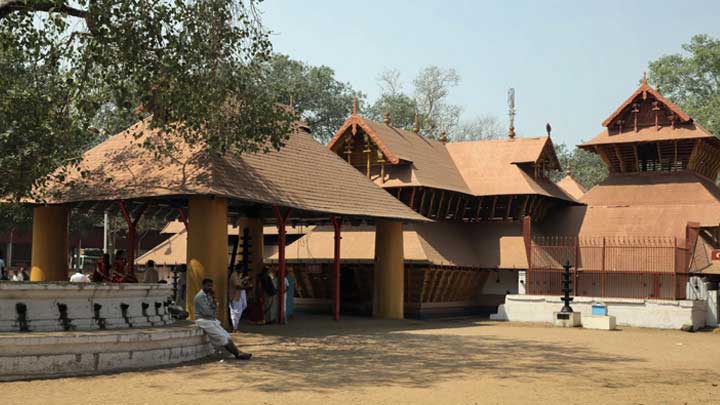
Temple from outside
The
temple stands in middle of an area that is spread across ten acres and
is surrounded by banyan and peepul trees. The sanctum sanctorum of the
temple is facing north. There is a chamber to the west of the main
shrine which houses the saptamatrikas or the seven divine mothers,
(Brahmi, Maaheswari, Vaishnavi, Indrani,Kaumari, Varahi and Nrisimhi.)
which also faces the north. It is very dark inside since it is lit by
just one small oil lamp, but as you go round the temple it is worthwhile
to stop and peer inside and you will have the vision of these huge
figures carved in stone. Inside the chamber there is also an idol of
Ganesha and one of Veerabhadra which is a fierce form of Shiva.
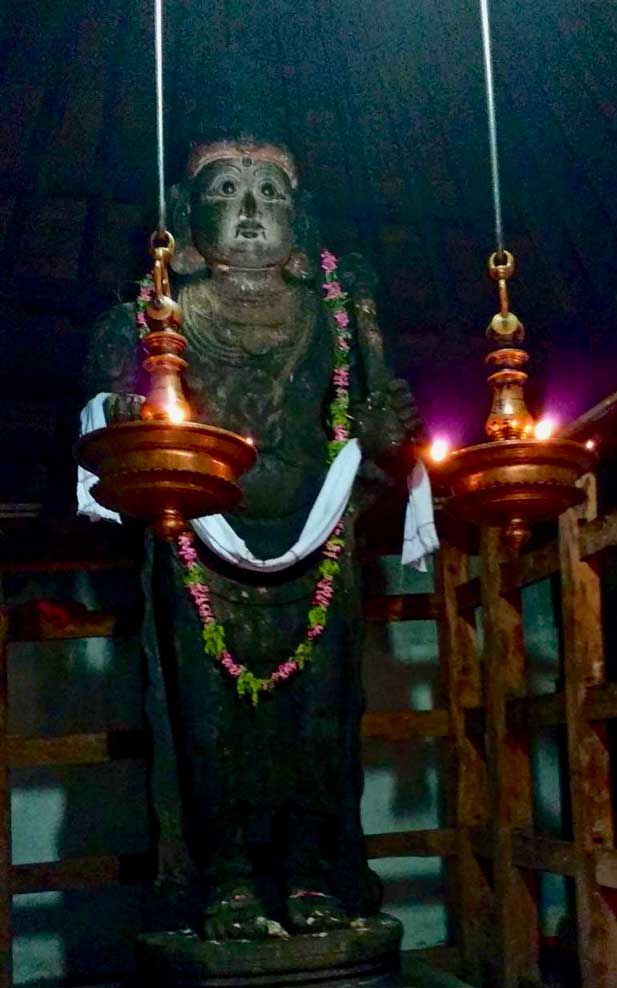
Kshetrapalan (guardian of the gate)
The
huge form of the Badrakali (Kali the fierce one) which confronts you
inside the sanctum has eight hands holding various things. This figure
is supposed to be carved out of the wood of a jack fruit tree. But since
she is always decorated we can’t make out the details. One hand is
holding the head of the demon king Daruka, another a sword, next an
anklet, which is probably the one which Kovalan was supposed to have
stolen, and another, a bell and so on. After Parasurama (6th incarnation
of Vishnu) created the land of Kerala, he was harassed by the demon
king Daruka. He prayed to Lord Shiva to help him. Shiva agreed and
opened his third eye. This figure of Kodungallur Devi is supposed to
have been born from his third eye in order to kill Daruka.
As
you stand in front of this huge figure which dominates the sanctum you
will notice that the pujari (priest) is sitting facing the east and not
facing her. He is doing puja to the three Sree Chakras or yantras of the
Devi which had been installed by Adi Shankaracharya. The Sree Chakra is
the most powerful yantra (mystic design) of the divine mother. All the
power in the temple emanates from these three chakras. Actually there is
a door directly opposite to these chakras which is opened only on
special occasions or when the Raja of Kodungallor comes for worship in
the early morning. We cannot see these yantras which are covered with a
gold topping but if we stand slightly to the right of the sanctum we can
see the gold lid covering the yantras.
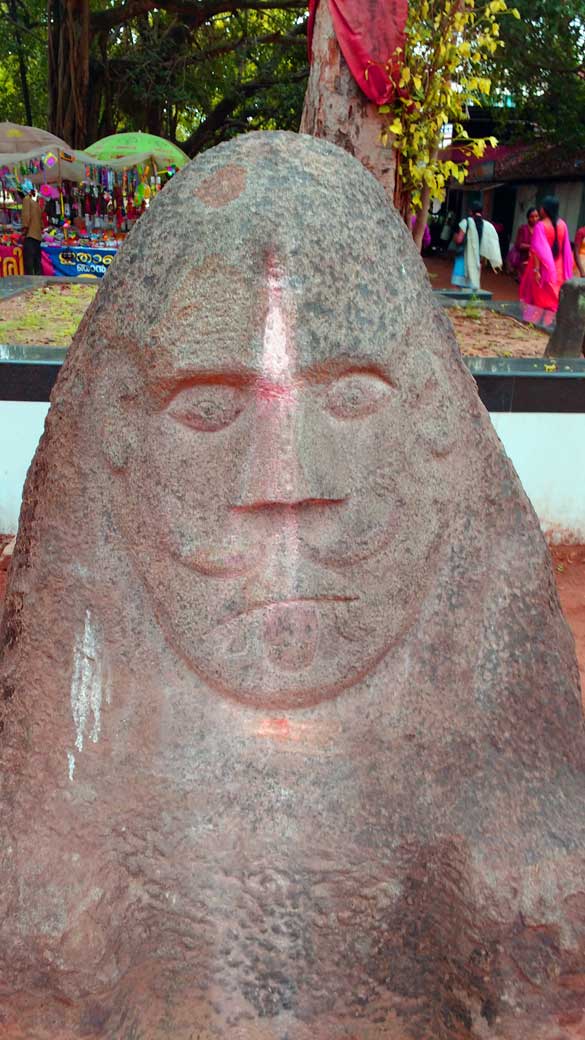
Stone face near which the cocks are killed
During
the time of the Kulashekara dynasty, Kodungallur was the capital of
Kerala. The temple history actually dates from the Chera period and is
intimately connected with the famous Tamil classic called
Silappadikaram. Kannaki was the heroine of this book which was a true
story which took place during the reign of the famous Chera king, Cheran
Chenguttuvan. Kannaki’s husband Kovalan was falsely implicated in the
theft of the queen’s anklets and put to death. In her grief and anguish
Kannaki plucked out her left breast and invoking her divine strength,
she reduced the city of Madurai to ashes. She was considered to be a
manifestation of Durga or Kaali. The temple of Kodungallur is said to
have been built to commemorate her martyrdom, by the Chera King, on the
site of an ancient Shiva temple which still exists on the eastern side
of the sanctum. It has no Nandi in front as is usual in all Shiva
temples, but you will notice that the platform which is normally kept in
front of the main deity is kept in front of the Shiva temple. The
instructions for the puja here is said to have been given directly by
the goddess herself and puja is done first to Shiva and then to her.
The pujas here are not conducted by Namboodiris (Brahmins of Kerala) but
by Konkan priests from Mangalore. At different times of the day, she is
worshipped as Maha Saraswati, Maha Lakshmi and as Durga who had
incarnated as Kannaki. The temple opens at 3 am and closes at 9 pm.
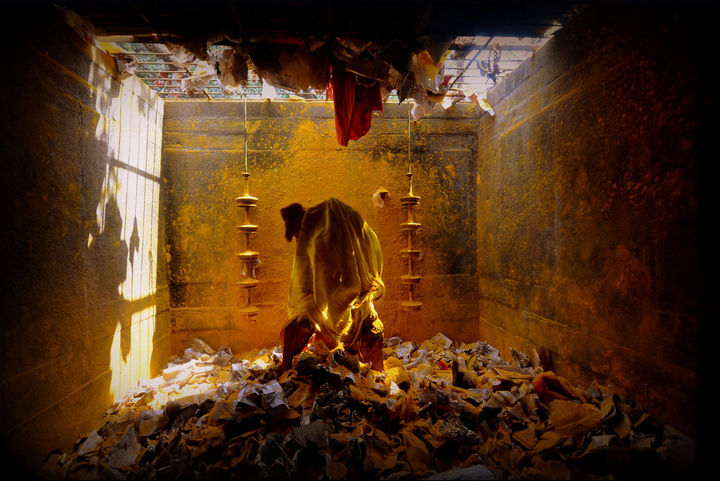
Shrine to the west of the temple in which devotees offer turmeric powder
An
aura of mystery surrounds this temple. The sprawling grounds are filled
with strange figures and spooky trees. The most mysterious place here
is the secret chamber to the east of the sanctum. The wall of this
chamber is made of granite and is right behind the three yantras. The
ceiling of the chamber is also covered with granite slabs. No one knows
when it was made and it has never been opened to date. Of course it is
suspected that it contains many precious articles which had been donated
to the goddess by the ancient kings of Kerala. There is also a saying
that there is a secret passage which leads to the Shiva temple of
Thiruvanchikulam which was the original sea port in which there is a
shrine to Kovalan apart from the main temple.
Kodungalloor
was the first temple in Kerala to allow the entry of all castes into
the temple long before the temple entry bill was passed by the
government. In olden days when small pox used to claim countless lives,
Kodungalloor Bhagavati was the only recourse for hundreds of people.
Even today on the left side of the temple, on the outer courtyard you
will find a small idol known as “vasuri mala.” “Vasuri” in Malayalam
means small pox and the idol here wears a garland made of small pox
pustules. A woman normally stands there and invites us to put a pinch of
rice bran over the idol. This is meant to ward off the dreaded disease.
On the right side of the of the outer courtyard you will another small
shrine again dedicated to the goddess who wards off all types of skin
diseases including chicken pox, measles, herpes and of course small pox.
This place is literally covered with a thick layer of turmeric powder
which is a great disinfectant and which was used in olden days to ward
off all infectious diseases. Even today a number of women hang around
the place selling packets of turmeric powder which we can buy and offer
to the goddess inside.
As
you enter the temple precincts on the eastern side there is a shrine
which houses a huge “Kshetra Palan” or guardian of the gate. He is a
very unusual figure to be seen in any temple since his figure is
massive. Normally the figures of “Kshetrapalans” are much smaller. So
this is another strange aspect of this temple. On the right side I also
noticed a huge face which I could not place. Since both these were on
the outside I was able to photograph them. Of course no one is allowed
to photograph anything inside the temple.
The
temple is famous for a strange festival known as Bharani which is held
in the Kerala month of Meenam (March/April). Bharani is the second
asterism of the Sanskrit lunar month and the festival takes place on
that day. This festival is mainly observed by the lower castes and has a
lot of quaint ceremonies connected with it. A large congregation
of human oracles known as Velichapads, of both sexes come to participate
in this interesting festival. The velichapad is a common feature of all
Devi temples but normally they are all male. This temple is unique in
as much as a lot of these velichapads who come to participate in this
ritual are females. Normally they get into states of ecstasy and are
able to foretell the future of the devotees who approach them. That is
why they are called oracles.
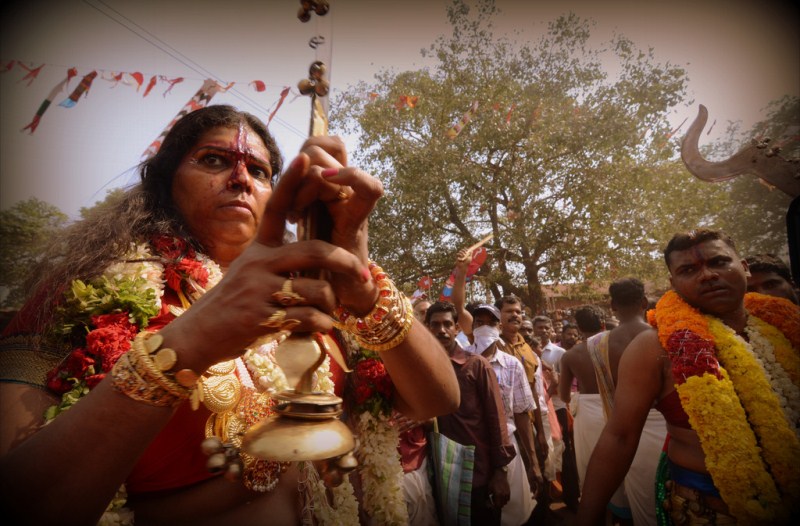
Female velichapad holding scimitar
The
festival officially opens with the ritual 'Kozhikkallu moodal' on the
Thiruvonam day of the month of Meenam. (Thiruvonam, like Bharani is
another asterism found in all months.) The ritual involves sacrificing a
cock on a red silk cloth placed near two stones that stand covered with
sand outside the path on which devotees go round the temple. The
members of the Kodungallur Bhagavathy family have the right to perform
this ritual. The first cock is offered by the Thacholi clan, the
ancestors of the popular hero Thacholi Othenan from Vadakara in North
Kerala. The ceremony symbolizes the beginning of the fight between the
goddess and the demon Daruka. The Goddess, Kali and her dependants are
supposed to revel in blood. Hence the sacrifice of the cocks form an
important part of this festival.
Oracles (velichapads) going round temple
After
this, flags belonging to the Venad family are hoisted on a peepul tree
in the north- eastern corner of the temple by Edamukku Moopan (the
chieftain of this clan) thus establishing the rights of his family over
the temple.
Pilgrims
flock to Kodungallur from all parts of Kerala bringing with them
offerings of rice, salt, dried red chillies, betel leaves and nuts,
turmeric, pepper and a number of cocks. It is believed that pilgrimages
undertaken to the temple on this occasion safeguard the devotees and
their friends and relatives from the devastating attacks of cholera and
small-pox for the rest of the year. Most of them make their offerings
and return home before the Bharani day when huge crowds start to
congregate.
On
the first day of Meenam, starting with Ashwathi, (the first asterism of
every month) the goddess is supposed to be having her monthly period.
This is known as “Kavu Theendal", and is the most important event of the
Bharani festival. It is overseen by the King of Kodungallur. A red
ceremonial umbrella is unfolded over the king's head. This is the signal
to begin the ritual.

Blood streaming from broken head of oracle
On
the Bharani day it is said that many Garudas, (the white-throated eagle
vehicle of Lord Vishnu) start circling above the secret chamber. In the
story of Kannaki, a goldsmith plays a crucial role, since he is the one
who actually stole the queen’s anklet and incriminated Kovalan. When
the eagles start circling, a goldsmith is made to come and ring a bell.
This is the signal for men wearing white dhoties to appear from all
round and start to chase the goldsmith around the temple three times.
They are followed by the oracles (velichapads). The men beat the ground
with sticks and others hurl sticks and stones and even cocks on the
temple roof so as to reach the inner courtyard.
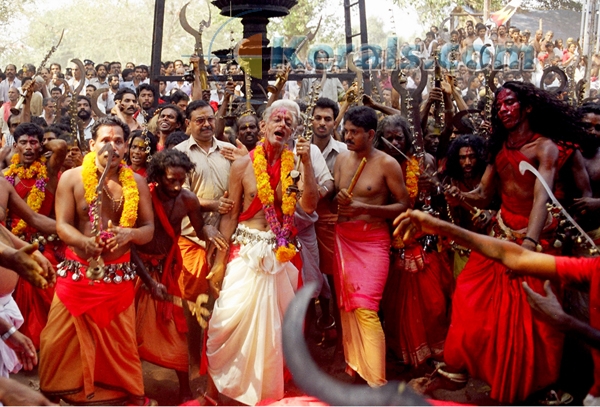
Velichapads dancing in ecstasy before the Devi
Imagine
the premises of the temple bathed in a sea of red as a flurry of
oracles draped in vermilion scurry around the temple brandishing their
swords which are shaped like sickles. They also wear huge bronze anklets
and their clothes are held up by belts studded with bells, all of which
make an incredible sound of crashing and tinkling as they rush around
in a trance with long hair flying in wild abandon. The noise made by
their anklets and the songs are supposed to purify the environment. The
highlight of the affair is when these hordes of women dance in divine
ecstasy along with their male counterparts. They go up and down
brandishing their scimitars and running their fingers through their long
locks, muttering all sorts of imprecations. The devotees who come to
watch the event are also inspired to chase after the oracles as they run
around the temple. Their cries of “nada- nada” is mixed with songs
containing abusive language leveled at the goddess. This is a peculiar
part of this festival. These abuses are supposed to be appreciated by
her. Perhaps this was a psychological method to bring out all the
suppressed and depressed negativity in the minds of the devotees into
the open in a way which was socially acceptable. This incredible event
called kaavu theendal forms the main part of the annual Bharani
festival. In fact the most abusive and abrasive song is supposed to get a
prize from the king!
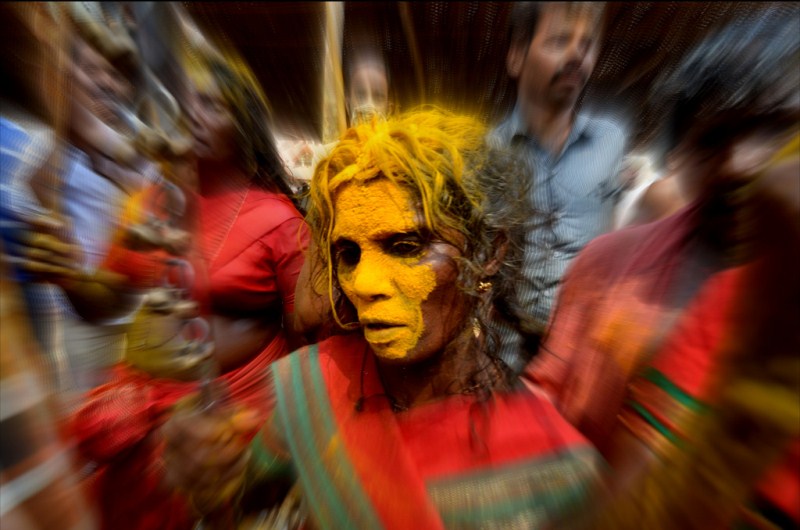
Female velichapad with face covered with turmeric
The
offerings by devotees include turmeric powder, kumkum (vermilion
powder), pepper etc and of course the cocks. A particular spot inside
the temple is set apart for the distribution of Manjal Prasadam
(turmeric powder on which divine blessings has been invoked). Some of
the devotees anoint themselves with turmeric, others dance and sing lewd
songs while some of the oracles go into a frenzy and break open their
heads with their swords. The uncontrollable bleeding is stopped by the
application of turmeric into the wound. This not only stops the bleeding
but closes the wound so well that no trace of it is left. The
velichappads and their followers display all their talent until they are
totally exhausted and at last they fall before the king for his
blessing.
Following
the custom which was prevalent in Kerala of cleansing the house after
the menstruation period of the women, the temple remains closed to the
public for a week. Its doors reopen after the 'purificatory' rituals are
conducted to cleanse the shrine of the 'stain' of Kavu Theendal. The
purification ceremony is conducted on Kartika day, the next day after
the Bharani. The premises of the temple and its vicinity are swept clean
and the wells purified. In the evening, the eastern door is opened and
the inner precincts are swept clear. This is the only time when
Nampoodiri (Kerala Brahmins) priests are allowed to go in and perform
the 'punnyaham' or purification ceremony. They also give away Pasu
Dhanam or gift of cows as an adjunct of the purification ceremony. The
usual daily poojas are resumed from the next day onwards. People flock
to attend this puja since you are supposed to get extra merit by doing
so. The pilgrims take home the 'prasada' consisting of sandal paste
mixed with turmeric and a black paint of burnt rice known as 'chantu'.
From the beginning of the killing of the cocks to the end when the
vellichapads dance around, red, the colour of blood dominates the scene.
The shedding of blood denotes the death of the ego.
The
next important festival here in known as Thalappoli. It is celebrated
in the month of Makaram (January/February) and corresponds with the
festival of Pongol in Tamil Nadu. The four day festival begins on Makara
Sankranti when the sun enters the astrological configuration known as
“Makara”. This is a far more dignified festival with music and elephant
processions carrying the figure of the goddess. The finale is a
procession by women dressed in traditional Kerala costume each carrying a
plate containing rice on which is placed a half coconut which is made
into a lamp with oil and a lighted wick. This is called Talappoli. A
caparisoned elephant walks in the middle of this procession. The
procession starts at a spot away from the temple and slowly winds its
way to the temple where a grand reception is arranged. May the blessings
of the divine mother fall on all who listen to this description of her
divine and unpredictable lilas (play).
Amme Narayana!